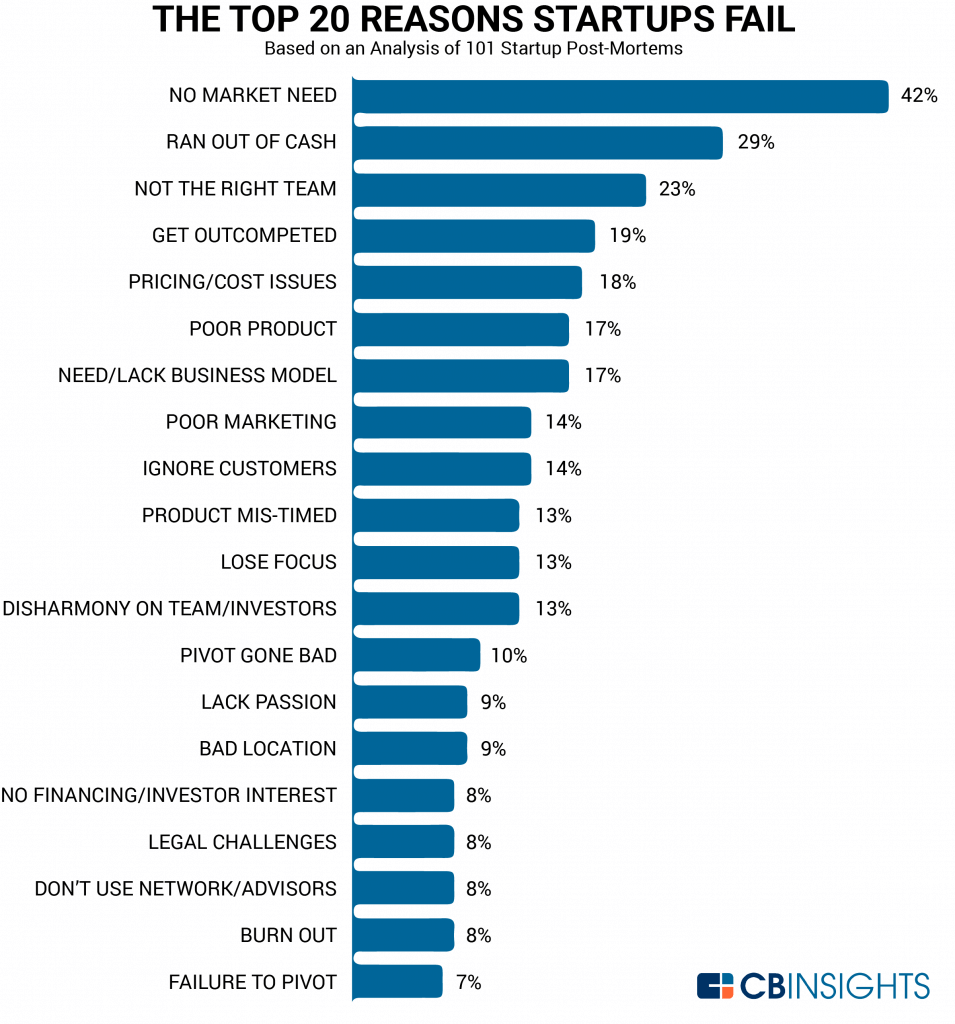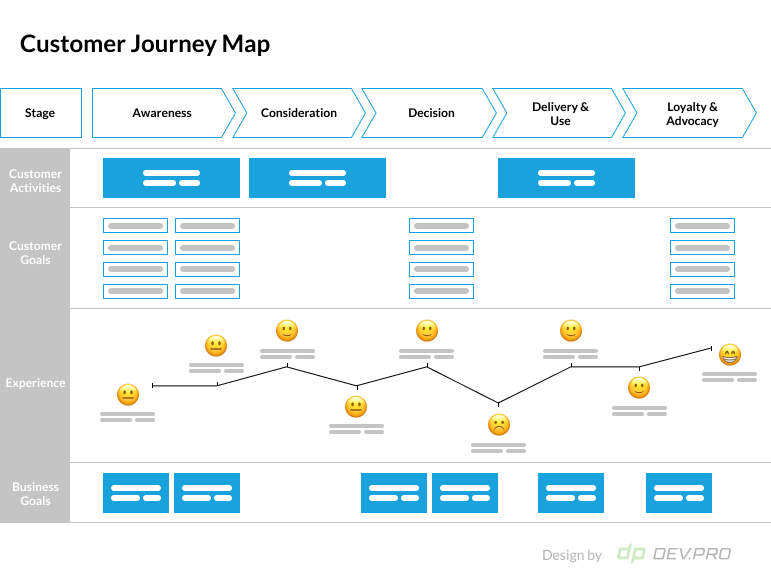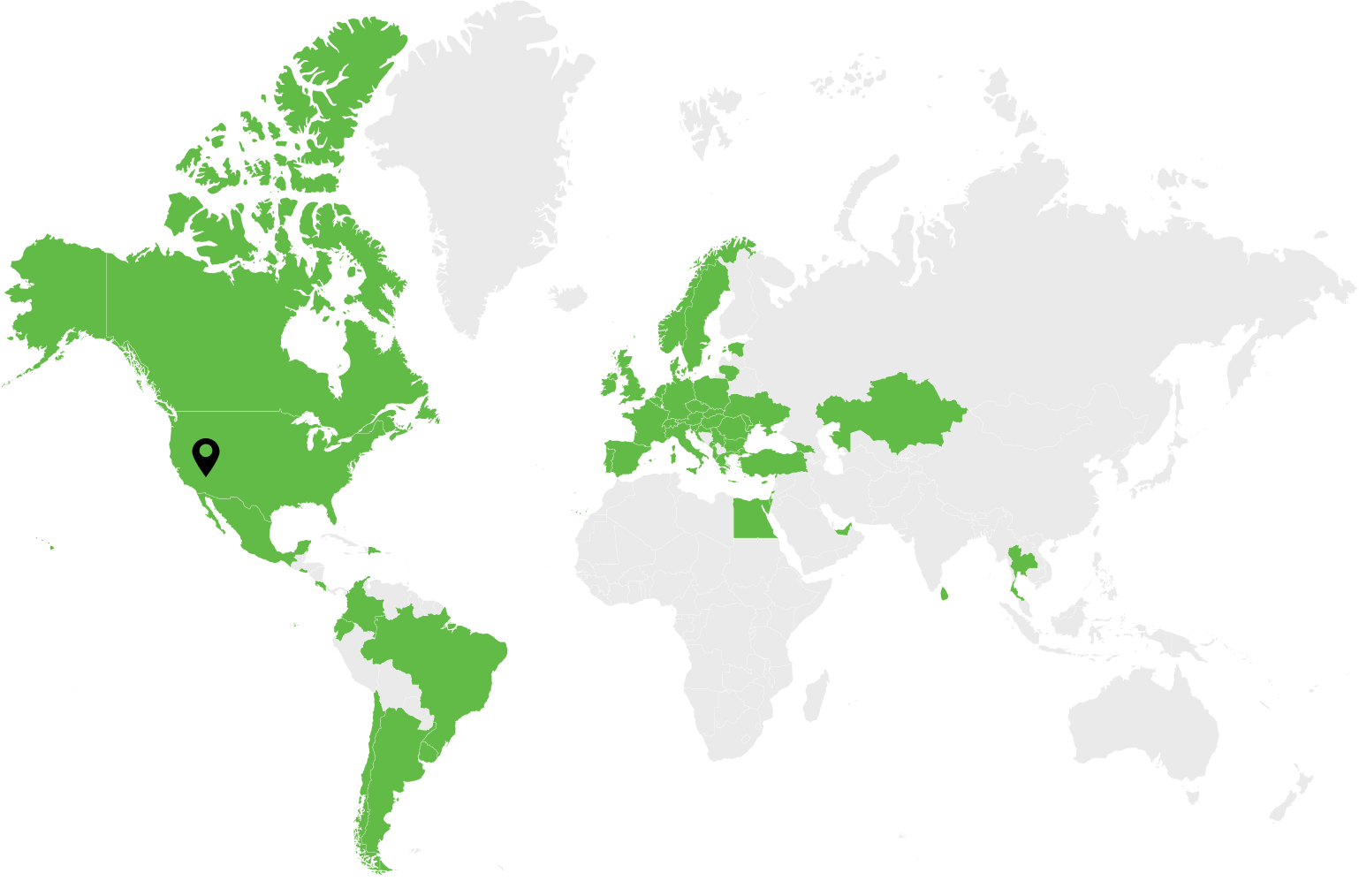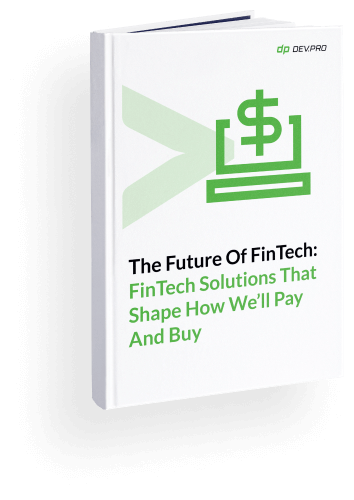When we need to buy a $400 coffee machine, we spend a few hours reading reviews, watching unboxing videos on YouTube, comparing technical features of different models, and even checking with family about which color to buy. But when it comes to investing tens or even hundreds of thousands dollars in a business idea, many prefer to save costs and skip the discovery phase altogether.
By ignoring the discovery phase of a project, you can end up dramatically increasing your final cost.
You could also be precipitating the demise of the idea altogether, even though it could have survived with a few market-tested tweaks.
From the 20 reasons for startup failures cited in this survey, the following top threats can be minimized or prevented altogether by conducting a proper discovery phase:
- No market need [this is the goal of the discovery phase in project management: to establish the market need]
- Being outcompeted [competition dissection is another focus of the SWOT analysis, which scrutinizes all current and potential threats]
- Pricing / cost issues [a price-positioning exercise is also on agenda for the discovery phase]
- Poor product [Product features are compared against current market leaders and user perception of the ideal product]
- Lack business model [business plan, monetization models, revenue streams, sales and marketing are all part of an extensive discovery model service]
- Poor marketing [User persona profiling and user journey map deliverables of the discovery phase are fundamental to marketing a product]
- Ignore customers [User surveys and focus groups help you keep the finger on the customer’s pulse]
- Poorly timed product [market ripeness is also ascertained during the discovery stage of UX research]
- Disharmony on the team / with investors [investors know there’s lots of bias in any startup, so a business idea should go through a market and user filter]

Why Does The Project Discovery Phase Matter?
A thorough preparation is half the battle won.
Prevention is better than cure.
Both of these sayings are a perfect description of the benefits of the project discovery stage: it helps to train your muscles, create the neural connections in your entrepreneurial brain to face future challenges and avoid potential costly pitfalls.
It helps to: Fail Early. Fail Fast. Fail Often
This Silicon valley mantra emphasizes importance of three qualities in an entrepreneur:
- Experience [and negative experience is even more valuable than successful one]
- Ability to recover and pivot [as Churchill said “Success is the ability to go from failure to failure without losing your enthusiasm”]
- Acceptance of intermediate failures as part of the final success formula [to learn to move from failure to failure with less cost, time, and effort]
If you have this entrepreneurial spirit embedded in you, taking your project to a UX/UI designer is a surefire way to train it with the highest ROI.
Cut Project Costs
Knowing your user, market fit, and competition is a hard currency in the startup universe. Assumptions that are not confirmed by market research and the founder’s idealized vision of the future of the venture often lead to expensive paths.
According to UX Planet, the ROI and savings from UX activities are extremely high: issues are 10 times cheaper to fix during the research phase than design phase. Moreover, when they go to production, they are 100 times more costly to correct.
Set Your Business Idea for Success
A UX 360 industry report confirms a direct correlation between the research stage and the success of the entire project. Around 82% of the surveyed believe that UX is most critical at the discovery stage of the project.

Discovery Phase Steps
- Understand the Company: History, Status Quo, and Goals
One of the main reasons an investor may say “no” to a project is a weak team. As a UX designer, you start your discovery project activities by learning all you can about the company, team, their goals, vision, and skillsets.
Having a good understanding of the client’s strengths and weaknesses will help you separate the wheat from the chaff: glossy vision of a founder from the fact-driven reality of a market.
Ask yourself these questions:
- Are they a startup, established company, or serial entrepreneurs?
- Have the team known each other for a long time? What’s their history of cooperation?
- How idealistic are they? Are they talking about global dominance tomorrow, or are they gauging every word carefully based on their audience?
- How much funds do they have now? Where does it come from? Are they in line with their burn rate? How urgent do they need an investment?
- How much domain knowledge do they carry? Is their background in the field of the project’s scope, an adjacent domain, or not related at all?
- How much visibility do they have on this business idea? How detailed is their understanding of the subject, business, or market?
- What toolkits and talent do they have at their disposal?
- Define & Interview Stakeholders
Your stakeholders will be introduced to you from the very start: a product owner, a founder, CTO, CFO, and HM are probably your go-to people at this stage. If the company has existing investors, check if you could also interview them about their expectations.
The minutes of the interview will be your reference point later on, so keep them filed and available for the entire team for better visibility.
They are part of the package of deliverables of the discovery stage.
- Review and Crystallize Business Requirement
Depending on the maturity of the team, you may end up with as much as the draft on a napkin or a full-fledged business plan and the pitch deck to start with.
Getting down to the finest detail of the vision of the business owners is your mission irrespective of the initially provided info.
The business requirements document should contain:
- Info about the industry, and the local and global market
- User profile as seen by the client
- General product description and application
- Product features
- USPs and differentiators
- Potential roadblocks and obstacles
- Budgets available and vision of the future funding
- Team inventory available now and team reqs for later stages
Irrespective of the original input, it’s a UX designer’s job to create a comprehensive and detailed business requirements case based on stakeholders interviews, market knowledge, and user persona research.
- Study Existing Documentation
Request and study all documentation currently available with the team.
Ask for a specific list of docs that you need and note that it would be beneficial to receive all papers available for the project for the best results. While a UX/UI company can build a case out of thin air and the market, the quality of the output does depend on the quality of the input.
- Create User Persona Profiles and a Journey Map
A persona profile is one of the most critical deliverables of the UX process and its discovery phase. It describes main behavioral, financial, and demographic characteristics of the ideal user.
A journey map covers the major touchpoints of a brand and its users, providing understanding of the customer acquisition, retention, and loyalty framework as well as features and descriptors that will benefit the product.
We will cover both deliverables in detail later in the article.
- Research Market and Competition
Market research may lead to full closure on the project, revealing why the previous attempts at similar products failed and providing insight into the market fit. It’s critical to research:
- Local, national, and global markets
- Adjacent industries [HealthTech and InsurTech, FoodTech and RestaurantTech]
- Immediate addressable markets and expansion plan targets.
- SWOT analysis of your offering against competition
The value of a competition overview cannot be overestimated and it should never be taken lightly. If a certain niche is overcrowded, there is a reason for it. If a certain niche is empty – this smoke, too, is not without the fire.
- Conduct Analysis of a Project’s Leaders, Losers, and Reasons
Are comparable products on the market? Have there been attempts to produce a similar software? Venture capital thrives on exposure and pitch decks, so there are likely digital traces of notable previous attempts. Make sure to research the following aspects:
- Leaders and losers and the reason behind their path
- Financials and stats, market cap and share distribution among players
- Best-selling products and monetization models
- Inventory of Resources: Time, Team, Budgets
Even though this is part of the business requirements analysis phase, doing an inventory of all resources at this advanced stage yields better results, as you have more input and better understanding of the project.
Based on the market and competitor research, draft a list of your team for each stage of the project, and estimate your budgets and deadlines.
- User Research
Product owners often identify themselves with users, though they are not a typical representative of the target audience.
User research that involves a number of qualitative and quantitative methods provides a real life avatar of a User persona and allows companies to trace their journey map.
- Create a Roadmap & Other Deliverables
At this stage all the information is gathered and it’s time to systemize all the knowledge into a digestible format for the client. It’s a point of reference for multiple teams at every phase of the SDLC [software development life cycle]: through design, coding, building, testing, deployment and maintenance.
Nota Bene:
It should be noted that the above are the traditional steps of the discovery stage that are applicable for the majority of product companies. As an outsourcing software development vendor, Dev.Pro will usually get access to projects at a later stage, when all of the marketing part has been done and risks are already determined.
This is why our UX / UI services will be more technical. We tend to focus on:
a. Evaluation of weather what our Client wants is doable technically;
b. Research of the body of information about their product to accumulate knowledge, expertise for further team staffing and preparation of a more precise proposal.
Discovery Phase Deliverables: User Persona, Journey Map, and Roadmap
A package of project discovery phase deliverables may include the following documents:
User Avatar [User Persona]
There can be a few user avatars for one product. Moreover, this tool is most efficient when used and updated regularly by the sales, marketing, and operations teams.
Norman Nielsen group defines three Persona Types:
Lightweight or Proto Persona
This is a quick outline of the general characteristics of a user based on team assumptions and a quick market scan. It’s used for team alignment.
Qualitative Persona
A qualitative persona is based on a small scale of qualitative research methods, like interviews, field studies. They are the best fit for most of the cases.
Statistical
Statistical persona is used for larger scale projects and uses big data sets to arrive at results. So a large-sample pool of data is used to crystallize a persona that is derived from existing statistics.
The User Avatar deliverable will include:
- Demographics: age, gender, location
- Professional Info: place of work, channels of communication, role, responsibilities, remuneration, bonuses
- Personal Info: family status, financial assets, vacation habits, hobbies, channels of communication and social media preferences
- Traits of character: anything pertinent to the existing research, including generational characteristics
The format of the User Avatar [or User Persona profile] depends on the industry, as some factors may be of more importance in certain industries. HealthTech products may pay extra attention to eating habits, exercise, and genetics, for example.
User Journey Map
Customer journey map deliverables are particularly important for the design of a software product or an application. It allows you to create a chain of events, activities, and consequences, executed by a user at each step of the process.
Knowing the motifs, hesitations, pains and desires of a user and how they are counteracted helps create a product that resonates with the user and gets recommended.
The document may include these data points:
- Customer activities
- Customer goals
- Communication channels
- KPIs
- Organizational activities
- Organizational goals
- Customer experience [emotional connotation]

Roadmap
A roadmap of the project can take a few forms, with a high level overview having major milestones and estimates of time, team, phases, and responsibilities. A more detailed roadmap may take the shape of a Gantt chart with weekly task breakdowns for each team.
Discovery Phase Proposal
This document wraps up all of the gathered materials, hypotheses, and facts. It should provide a clear set of recommendations on how to take the project forward, or rationale for ending the project.
How to Run the Discovery Phase for Your Product
Many investors will take the presence of a discovery phase executive summary as a signal of how mature and prepared a team is to face the harsh reality of startup life. They’ve seen too many idealistic teams take millions of venture capital and waste it on unsubstantiated dreams.
While there are many good examples of project discovery phase templates to DIY this process, hiring a UX company will ensure a fact-based approach, where your vision and results are not blurred by the product owner’s infatuation with the idea.
Make sure you provide as much information and documents as possible to vendors and take time to review the deliverables of the project together with the team. Be prepared for a “no” or to pivot based on the results.
Getting a market-proven view on your project is a sobering experience, but prevention is much better than a cure.
On the other hand, if you order your UX/UI service with a software engineering company, you minimize the chances of unexpected surprises in your timeline and budgets. You also get to know a vendor, so if the project is feasible for development, your company has a first vendor for your software development shortlist.
Dev.Pro has delivered 150+ projects for US clients. Our UX/UI team can conduct an audit, guide you through the project discovery phase, or execute a full-cycle UX/UI development. Contact our team to validate your idea against the market.

